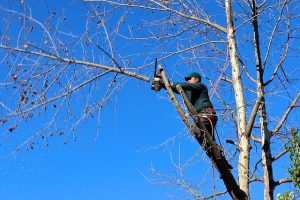 Print a Sign-In Sheet | Spanish Version
Print a Sign-In Sheet | Spanish Version
Always Assume That Power Lines Are Energized!
- If clearing trees, contact the utility company to discuss de-energizing and grounding or shielding of power lines.
- Extreme caution is necessary when moving ladders and other equipment around downed trees and power lines.
- Always perform a hazard assessment of the work area prior to the start of work.
To “fell a tree” means more than just cutting it down. Felling means to cut the tree in such a way that it falls in the desired direction and results in the least damage to the tree.
To safely fell a tree, you must eliminate or minimize exposure to potential hazards found at the tree and in the surrounding area. the Occupational Safety and Health Administration (OSHA) Standard 29 CFR 1910 Subpart R outlines the regulations for properly felling a tree. Here are some important reminders:
- What hazards are present in the area where the logger will be working?
- Determine the felling direction and how to deal with forward lean, back lean, and/or side lean.
- Provide a retreat path so the logger can reach safety while the tree is falling.
- Determine the proper hinge size to safely guide the tree in its fall.
- Proper felling methods allow the logger to safely fell the tree.
- Look out for hazards and make sure you know where everyone is located!
- Always use proper personal protective equipment (PPE) as recommended by the manufacturer’s operating manual, including eye, face, head, hand, and foot protection.
- Additional hazards that may cause an injury include broken or hanging branches, attached vines, or a dead tree that is leaning.
- If you have to cut a dead tree, be careful. The top could break off.
- If the tree is broken and under pressure, make sure you know which way the pressure is going. If not sure, make small cuts to release some of the pressure before cutting up the section.
- Be careful of young trees that other trees have fallen against. They act like spring poles and can propel back.
- A tree may be lodged against another tree. Extreme care must be taken to safely bring the trees to the ground.
- If possible, avoid felling into other trees or objects. Don’t turn your back on the tree as it falls and hide behind a standing tree if possible.
- As trees fall through other trees or objects, branches and objects may get thrown back toward the logger.
KEMI does not assume liability for the content of information contained herein. Safety and health remain your responsibility. This information is to be used for informational purposes only and not intended to be exhaustive or a substitute for proper training, supervision, or manufacturers’ instructions/recommendations. KEMI, by publication of this information, does not assume liability for damage or injury arising from reliance upon it. Compliance with this information is not a guarantee or warranty that you will be in conformity with any laws or regulations nor does it ensure the absolute safety of any person, place, or object, including, but not limited to, you, your occupation, employees, customers, or place of business.

